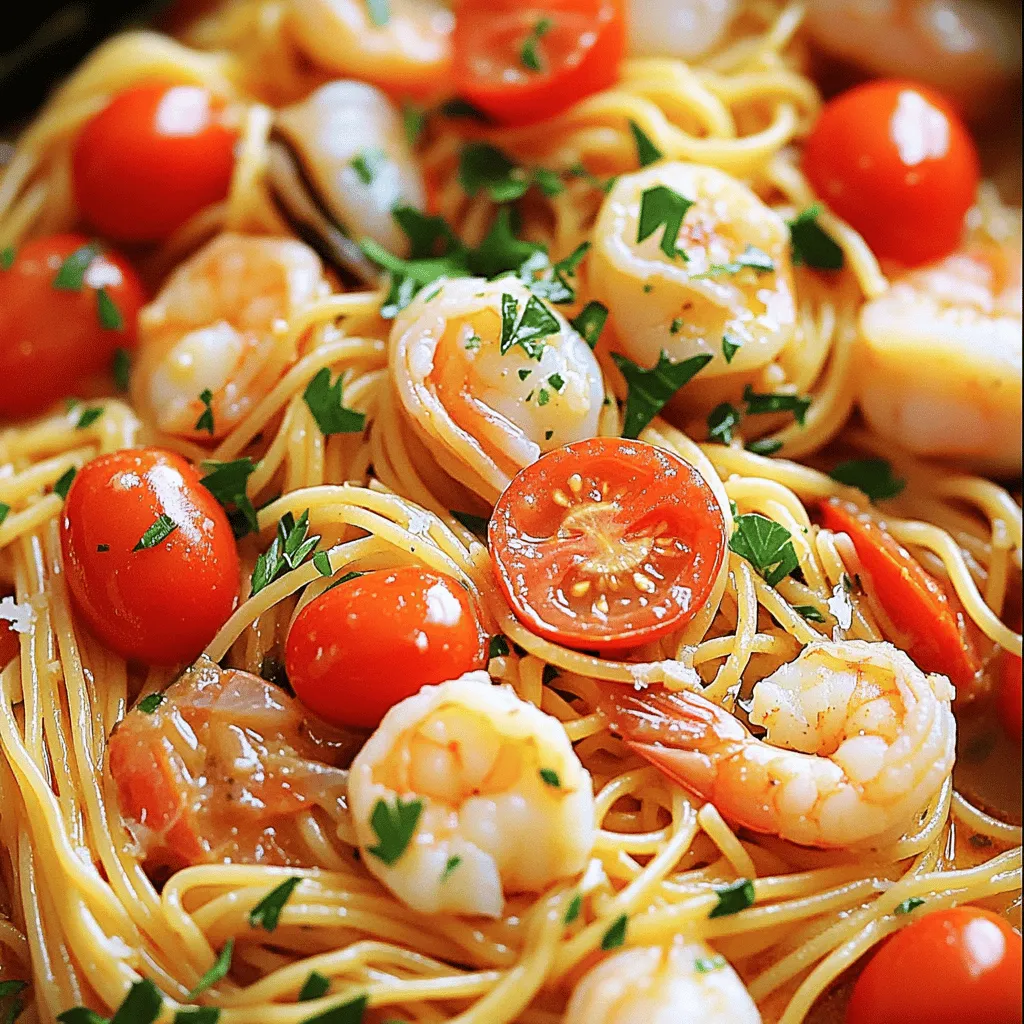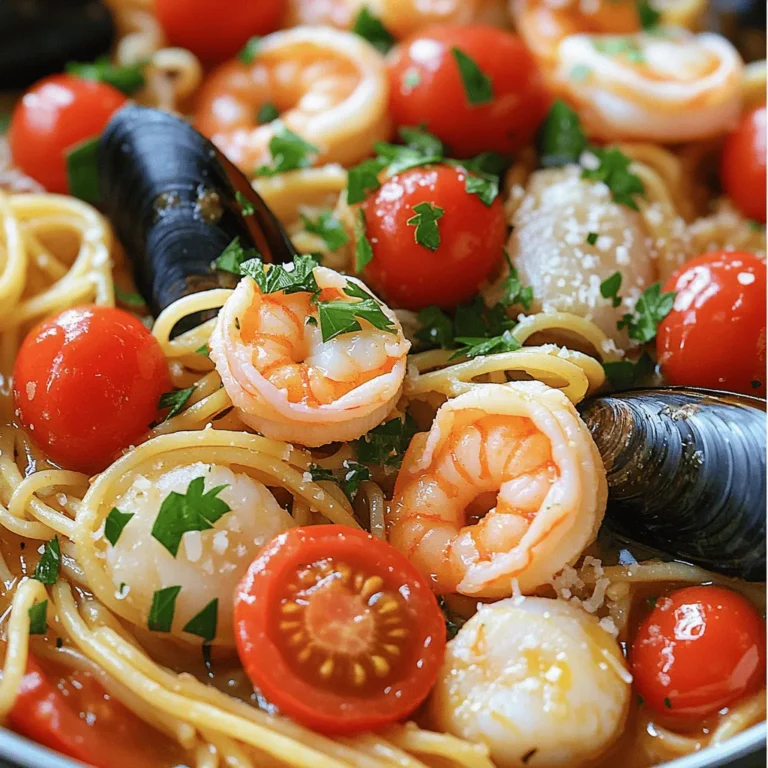Are you ready to make a seafood pasta that will wow your taste buds? In The Best Seafood Pasta Recipe Savory Delight Unveiled, I’ll share my secret steps to creating this delicious dish. You’ll find easy-to-follow instructions, tips for selecting the freshest seafood, and flavor-enhancing tricks that turn a simple meal into a gourmet experience. Let’s dive into this culinary adventure and elevate your dinner game!
Ingredients
List of Ingredients
– 8 oz spaghetti or linguine
– 1 tablespoon extra virgin olive oil
– 3 cloves garlic, finely minced
– 1 small onion, finely chopped
– 1/2 teaspoon red pepper flakes (or adjust to your spice preference)
– 1 cup cherry tomatoes, halved
– 1 cup shrimp, peeled and deveined
– 1 cup scallops, cleaned and patted dry
– 1 cup mussels, cleaned and debearded
– 1 cup vegetable broth
– 1 tablespoon fresh lemon juice
– Fresh parsley, coarsely chopped (for garnish)
– Salt and freshly ground black pepper to taste
– Grated Parmesan cheese (optional)
Quality Seafood Tips
Choosing fresh seafood
When picking seafood, look for bright colors and clear eyes. Fresh seafood should smell like the ocean, not fishy. This ensures you get the best flavor in your dish.
Understanding frozen vs. fresh seafood
Frozen seafood can be just as good as fresh. It’s often frozen right after being caught. If you choose frozen, look for packaging that is intact and check the date.
Tips for cleaning and preparing seafood
Before cooking, rinse seafood under cold water. Remove shells and any inedible parts. For shrimp, devein them for better taste. Clean mussels by scrubbing their shells under cold water. This step keeps your dish clean and tasty.
Step-by-Step Instructions
Preparing the Pasta
Cook spaghetti or linguine in a large pot of boiling water. Add a pinch of salt. Follow the package instructions until the pasta is al dente. This means it should be firm but not hard. After cooking, drain the pasta but save half a cup of the water. This water has starch, which helps bind the sauce later.
Sautéing Aromatics
In a large skillet, heat olive oil over medium heat. Add minced garlic and chopped onion. Sauté for about three to four minutes. Stir often until the onion turns translucent. This step releases sweet flavors. The aroma will fill your kitchen, making it hard to wait for the next step.
Cooking the Seafood
Now, add shrimp, scallops, and mussels to the skillet. Pour in the vegetable broth and cover with a lid. Let it simmer for five to seven minutes. Covering helps the seafood cook evenly and steam properly. You’ll see the mussels open up, signaling they are done.
Combining Ingredients
Once the seafood is cooked, remove the lid. Add the drained pasta into the skillet. Gently fold everything together so the pasta combines well with the seafood. If the mix seems dry, add a splash of reserved pasta water. This makes the dish creamy and helps the sauce cling to the pasta.
Final Garnish and Serving
Serve the seafood pasta hot. Garnish with chopped fresh parsley for color and flavor. If you like, add grated Parmesan cheese on the side. This dish looks great and tastes even better! Enjoy it with a nice glass of white wine for a complete meal.
Tips & Tricks
Enhancing Flavor
To make your seafood pasta even better, you can add spices and herbs. Consider using fresh basil or oregano to brighten the dish. A pinch of saffron adds a lovely depth. You might also enjoy using a splash of white wine for extra flavor. If you prefer broth, swap vegetable broth with seafood broth for a richer taste.
Cooking Techniques
Sautéing is key for great flavor. Start with garlic and onion to build your base. Cook them until they are soft and fragrant. When you add the seafood, simmering is essential. It helps cook the seafood evenly and keeps it juicy. Make sure to cover your skillet while it simmers. This helps the mussels open and ensures shrimp and scallops are done just right.
Serving Suggestions
Pair your seafood pasta with a crisp white wine, like Pinot Grigio or Sauvignon Blanc. A fresh salad with lemon vinaigrette is a perfect side. For a formal dinner, serve the pasta in individual bowls. You can sprinkle fresh parsley on top for color. If you like cheese, offer grated Parmesan on the side. It adds a nice touch and lets everyone customize their plate.
For the complete recipe, check out the Ocean’s Bounty Seafood Pasta .

Variations
Seafood Pasta Variations
You can change up your seafood pasta by using different types of seafood. Try adding crab or lobster for a rich taste. These options give your dish a new twist. You can also mix in seasonal vegetables for a vegetarian version. Fresh zucchini, bell peppers, or asparagus can brighten your plate. This way, you make a meal that suits any diet.
Pasta Alternatives
If you need a gluten-free option, use gluten-free pasta. Many brands offer tasty alternatives that hold up well. You can also experiment with other types of noodles, like rice noodles or even quinoa. These choices add variety and can enhance the dish’s texture.
Flavor Profile Variations
Changing the sauce can transform your seafood pasta. A white wine sauce can add a lovely depth. For a creamier taste, try a garlic cream sauce. You can also adjust the spice level. If you like it hot, add more red pepper flakes. For a milder taste, skip them altogether. This lets you create a dish that fits your flavor preferences perfectly.
Storage Info
Proper Storage Techniques
To store leftovers, first let the seafood pasta cool down. Then, place the pasta in an airtight container. Make sure to seal it well. This helps keep the flavors fresh and tasty. Use a glass or plastic container for best results. Avoid metal containers, as they can react with the seafood.
Freezing Instructions
To freeze seafood pasta, let it cool completely. Then, divide it into portions. Use freezer-safe bags or containers to store the portions. Squeeze out as much air as possible before sealing. This helps prevent freezer burn. When you’re ready to eat, thaw it in the fridge overnight. For reheating, warm it gently in a skillet. Add a splash of broth or water to keep it moist.
Shelf Life
Cooked seafood pasta lasts in the fridge for about 3 days. If you freeze it, it can last up to 3 months. Uncooked pasta can stay good in your pantry for about a year. Look for signs like an off smell or slimy texture. If you notice these, it’s best to discard the dish. Trust your senses to keep meals safe and enjoyable.
FAQs
What is the best seafood for pasta?
For the best flavor and texture, I recommend shrimp, scallops, and mussels. These seafood choices pair well with pasta. Shrimp adds sweetness, scallops bring a buttery taste, and mussels contribute a briny flavor. You can also try crab or clams for a different twist. When selecting seafood, look for freshness. Fresh seafood has a clean smell and firm texture.
How can I make seafood pasta gluten-free?
You can use gluten-free pasta made from rice or corn. Many brands offer good options. Also, check labels for any hidden gluten in sauces or broths. You can swap regular pasta for zucchini noodles, too. It’s a great low-carb option, and it absorbs flavors well.
Can I prepare seafood pasta ahead of time?
Yes, you can prep some parts ahead. Cook the pasta and store it in the fridge. Prepare the seafood and sauce separately, then combine them right before serving. This method keeps everything fresh. If you cook it all together, the seafood may become tough when reheated.
How to reheat seafood pasta properly?
To reheat seafood pasta, use a skillet over low heat. Add a splash of broth or water to keep it moist. Stir gently until warmed through. Avoid using the microwave, as it can overcook the seafood. This method helps maintain the dish’s flavor and texture.
Is seafood pasta healthy?
Seafood pasta can be healthy! Seafood is rich in protein and omega-3 fatty acids. These nutrients support heart health and brain function. Pair it with whole-grain pasta to increase fiber. Just watch the portion sizes and added sauces, as they can add extra calories.
What can I serve with seafood pasta?
Seafood pasta pairs well with a simple salad or garlic bread. You can also serve it with a light white wine or sparkling water. For a complete meal, add seasonal vegetables like asparagus or spinach. These sides enhance the dish and make it more satisfying.
This blog post outlined the key ingredients and steps for making a delicious seafood pasta dish. You learned about selecting quality seafood, preparing pasta, and cooking techniques. There are many variations to suit your taste and dietary needs. Always store leftovers properly and know how to reheat them for the best flavor. Remember, cooking should be fun and rewarding. With these tips, you can enjoy great seafood pasta at home any day. Dive in and enjoy your culinary journey!


